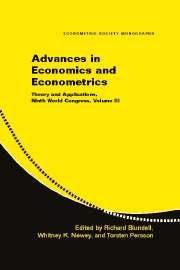Book contents
- Frontmatter
- Contents
- Contributors
- Introduction by the Editors
- 1 Identification of Nonadditive Structural Functions
- 2 Nonadditive Models with Endogenous Regressors
- 3 Heterogeneity and Microeconometrics Modeling
- 4 Heterogeneous Choice
- 5 Modeling Heterogeneity
- 6 Inference with Weak Instruments
- 7 Empirical Likelihood Methods in Econometrics: Theory and Practice
- 8 Weak Instruments and Empirical Likelihood: A Discussion of the Papers by D. W. K. Andrews, J. H. Stock, and Y. Kitamura
- 9 Estimating Continuous-Time Models with Discretely Sampled Data
- 10 Variation, Jumps, and High-Frequency Data in Financial Econometrics
- 11 Discussion of Aït-Sahalia and Barndorff-Nielsen and Shephard
- 12 Understanding Bias in Nonlinear Panel Models: Some Recent Developments
- 13 Fixed and Random Effects in Nonlinear Panel Data Model: A Discussion of a Paper by Manuel Arellano and Jinyong Hahn
- Index
- Titles in the series
8 - Weak Instruments and Empirical Likelihood: A Discussion of the Papers by D. W. K. Andrews, J. H. Stock, and Y. Kitamura
Published online by Cambridge University Press: 05 January 2013
- Frontmatter
- Contents
- Contributors
- Introduction by the Editors
- 1 Identification of Nonadditive Structural Functions
- 2 Nonadditive Models with Endogenous Regressors
- 3 Heterogeneity and Microeconometrics Modeling
- 4 Heterogeneous Choice
- 5 Modeling Heterogeneity
- 6 Inference with Weak Instruments
- 7 Empirical Likelihood Methods in Econometrics: Theory and Practice
- 8 Weak Instruments and Empirical Likelihood: A Discussion of the Papers by D. W. K. Andrews, J. H. Stock, and Y. Kitamura
- 9 Estimating Continuous-Time Models with Discretely Sampled Data
- 10 Variation, Jumps, and High-Frequency Data in Financial Econometrics
- 11 Discussion of Aït-Sahalia and Barndorff-Nielsen and Shephard
- 12 Understanding Bias in Nonlinear Panel Models: Some Recent Developments
- 13 Fixed and Random Effects in Nonlinear Panel Data Model: A Discussion of a Paper by Manuel Arellano and Jinyong Hahn
- Index
- Titles in the series
Summary
INTRODUCTION
These two papers represent the fruition of important and thorough investigations undertaken by the authors of their respective fields of enquiry. I feel that they will add considerably to our understanding of these topics. Before describing the contents of my discussion I initially and briefly outline the contributions of both sets of authors.
Andrews and Stock (2005), henceforth referred to as AS, continues the program of research initiated with the papers by Moreira (2001, 2003) through Andrews, Moriera, and Stock (2004), henceforth AMS. Like those contributions, this paper is primarily concerned with the weak instrument problem for the classical two variable linear simultaneous equations model with normally distributed reduced form errors and known error variance matrix. The particular advantage of using a well-understood classical framework for analysis is that results here as elsewhere should have important implications and conclusions for estimators and statistics in more general settings enabling specific recommendations for practice. Apart from reviewing and detailing existing results, this paper provides a comprehensive treatment of the many weak instrumental variables problem for this model. Generally speaking with weak instruments standard point estimators such as 2SLS and LIML are no longer consistent and have nonstandard limiting distributions which cannot be consistently estimated. Therefore recourse is typically made to tests based on unconditionally or conditionally pivotal statistics. Acceptance regions associated with these tests may then be inverted to provide valid confidence interval estimators for the parameters of interest. I now briefly summarize their findings and conclusions.
- Type
- Chapter
- Information
- Advances in Economics and EconometricsTheory and Applications, Ninth World Congress, pp. 238 - 260Publisher: Cambridge University PressPrint publication year: 2007



